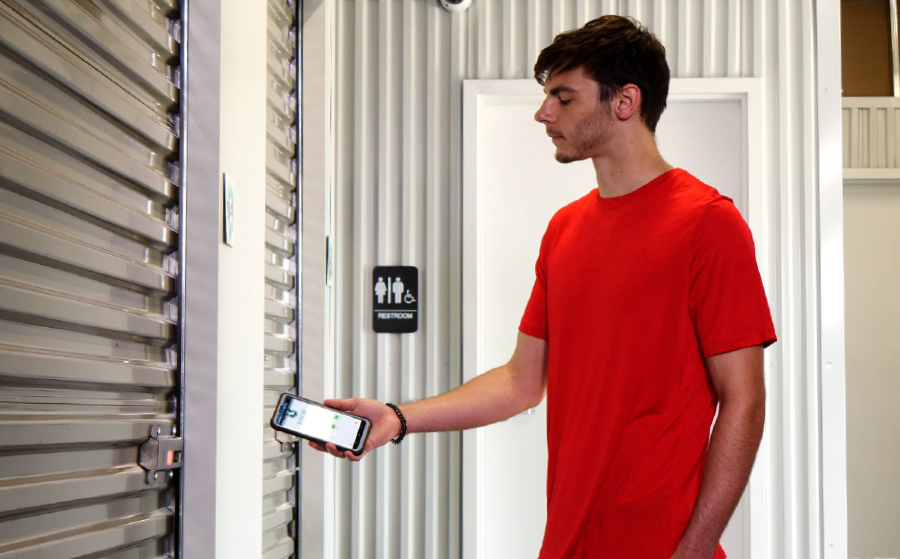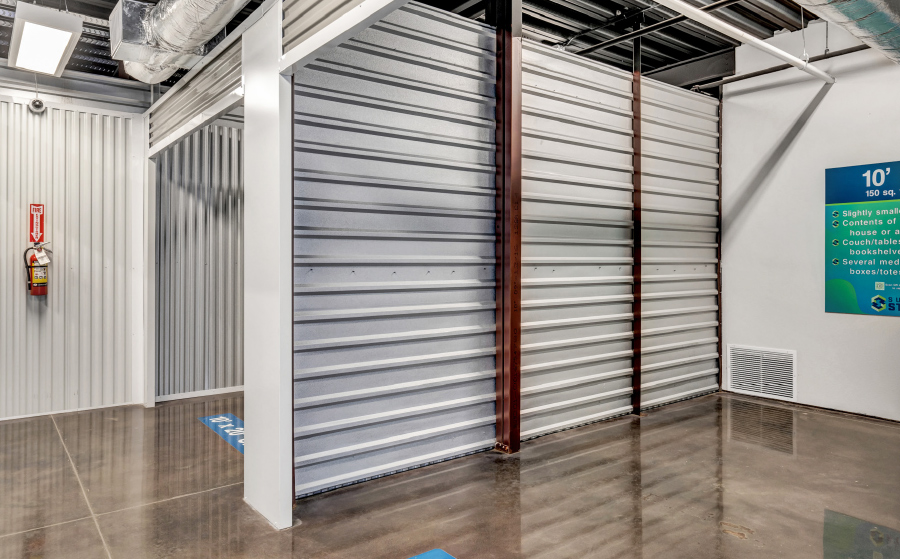Tyler, Texas

n the seemingly endless evolution of technology, the limelight shines the brightest on the “smart” category. But what exactly is smart technology? Williams College’s Office for Information Technology defines smart technology as “the integration of computing and telecommunication technology into other technologies that did not previously have such capabilities. What makes a technology ‘smart’ is its ability to communicate and work with other networked technologies, and through this ability to allow automated or adaptive functionality as well as remote accessibility or operation from anywhere.”
That “operation from anywhere” element hits self-storage where it lives as more operators are building facilities they can manage either partly or fully remotely.
Superior Storage’s latest of three facilities in Tyler, Texas, fits that description. The company built all five of its facilities with smart technology “from the bottom up,” says Adam Wagner, co-owner with Chris Chitwood of Superior’s latest Tyler facility, which is its first with boat and RV storage included. It won Modern Storage Media’s “Smart Facility of the Year Award” for 2023. Superior has another facility under construction and is planning several others.
Wagner says the company’s award-winning facility, referred to in-house as Tyler West, is among the only facilities he knows of that operate completely with technology, including its camera systems, the Nokē technology that gives tenants access to automatic doors on select boat and RV units, and its gate system. Its remote concierge manager (RCM) software enables completely remote, integrated property management.
“When a tenant comes into the office, it triggers motion,” he says. “We answer the motion from our corporate office in Longview, and we can walk that tenant all the way through the whole property, never losing that face-to-face connection. Whether it’s on the kiosk in the office or we transfer that video call to that tenant’s smart device, we thought of a way to do storage that’s outside of the norm and decided to integrate it all the way through.”

“The thesis of our company is we’d much rather run 100 percent remote with highly trained people in our corporate office that would then answer and manage those properties remotely,” he says. “We went from a thought process of, ‘We think this would be great’ to ‘Let’s dive all the way into the deep end and solve the issues as they come up, not just dip our toes to see if technology works.'”
Superior does face challenges, mainly when the technology doesn’t work as designed, Wagner says. Systems must have processes in place to solve those problems when they arise. The company developed a checklist to monitor and respond to such problems.
One of the biggest technological problems the industry faces is fragmentation, he says. A facility operator could have some technology components such as Nokē, cameras, and a security alarm system, but none of them is integrated with the others. Superior chose to partner with Tenant Inc. because its management software enables Superior to integrate these technologies and thereby better serve its customers.
“Technology can sometimes be very stale, like when you have a remote-managed property,” Wagner says. “It can seem sterile or not inviting. So, we try to jump over that hurdle. We try to be personable.”
Superior’s property managers visit their facilities in person to help them when they remotely direct tenants inside the facilities. The managers also keep schematics of the facilities on hand for reference.
“We can track the customer through the whole property,” Wagner says.
Superior’s prospective customers typically sign a rental contract within 15 minutes of walking into the facility, he says. He thinks that’s why they won MSM’s smart facility award, because they “cracked the code of how we can do this.” The company also has a contractor who comes to the site to address problems when they arise and walks through the property weekly.
The technology Superior uses is constantly evolving and has improved in the past several years, Wagner says. This includes cameras and property management systems.
“Things have gotten a whole lot smarter and faster,” he says. “Our core belief is a lot of times older-school facility owners don’t believe in remote storage management. We go out and find a solution if something doesn’t work.”
Wagner thinks the way Superior uses technology will become the norm in self-storage. Younger people are the largest generation using storage. They are familiar with using technology and not interacting with people to get services. They use technology in every aspect of their lives. He wants “to learn how to meet my customers where they’re already transacting.”
Tenant Inc.’s management software enables Superior to make that meeting with its customers happen in ways they’re accustomed to.
Tenant CEO Lance Watkins says the key distinction between its property management system and its competitors’ systems is that Tenant’s is built entirely as a vertically integrated software as a service (VSAS). Most other systems are “horizontally built,” meaning they function independently of one another instead of being integrated into one system.



Tenant Inc. started in software more than 10 years ago on the consumer side for e-commerce. “We were inventing things as basic today as renting storage units online,” Watkins says. “Before COVID, not a single company could rent storage online. As we continued to build to the end user, we continued to find challenges with lack of integration. Data was slow and much of it incompatible. Those systems were designed in an era when doing business online wasn’t even considered, wasn’t a reality. So, we designed them.”
Tenant had been building tools to conduct business online. The idea of remote management of self-storage “was already in our wheelhouse,” Watkins says. “The smart storage facilities that are out there now, like Adam Wagner’s, were trying to accomplish a lot of things for the customer where the storage manager may or may not be present. I like to think of our software being reverse compatible, meaning that traditional software stacks may serve the customer well if there’s a person there to operate them. But if there’s not a person there to operate them, they collapse with a lot of deficiencies. If you can serve the customer efficiently without a person there, you can also reverse to, obviously, if you’re staffed.”
Wagner is on the cutting edge of using remote management in self-storage and “taking it to another level,” Watkins says. Several other operators are also doing that. And now some of the big REITs are, too. He has stores that close the office two days a week. An efficient remote-management system allows that. Tenant had tackled many issues for years that enabled it to find greater efficiency for running facilities fully remotely. One of the things the company does that others don’t is build tools that help remote managers cycle through their facilities to manage delinquencies.




A tool like Storage Treasures makes remote management much easier, according to Watkins. The company also unifies all forms of communications with its customers in a cloud-based system. This integration helps with auditing a customer, for example. Having all this information in one place is crucial if you’re managing properties remotely.
Talent uses the Hummingbird property software system. It uses Mariposa for the consumer interface, and it uses a “data orchestrator” called Nectar. All of them are fully integrated.
Smart storage operators “are flocking to us,” Watkins says, largely because of the Nectar system. “It almost feels casual, having a conversation as you move through the space. We encourage these types of new methods and systems. What’s different about Tenant is we designed it from the ground up to help them innovate. Newer operators have ideas and need to integrate. We give them that access and they go to town and stand up their proof of concepts and succeed quickly or pivot when they fail.”
Watkins describes a large self-storage operator that wanted to use digital wayfinding maps. It’s good technology. The operator spent a year and a half integrating it with its systems but was dissatisfied with the technology. The company contacted Tenant, which got the system up and running within two days.
“That is a massive differentiator,” Watkins says. “For smart stores, wayfinding works its way into those systems. Not just for customers by providing good physical signage. But those tools make operations more efficient, maintenance, delinquent spaces. Maybe checking space after a customer moves out. You need good quick tools to do that. Our system gives the ability to do those kinds of things, manage your staff who’s communicating with the customer and goes to facility.”



Despite the importance of in-person customer service, “there are no great brands or services in America now that aren’t tech driven,” he says. “If you are a really good brand in today’s world, there’s a significant tech element.”
Self-storage has kept a low public profile for years, Watkins says, but that has changed because of the industry’s recession-resistant strength. Self-storage is “a need-based commodity, and you have to be super-efficient with a commodity to outperform the competition.”
“We’re also more retail, moving people in and out every day,” he says. “The public storage companies are waking up now to tech.”
Overall certificate of occupancy: Sept. 15, 2023
Net rentable square footage: 145,438
Number of units: 798
Co-Owners: Adam Wagner and Chris Chitwood
Builder: Trademark Construction LLC
Architect: Dallenbach Cole Architecture
Management software: Tenant Inc.
Security system: Nokē Smart Entry by Janus International
Roof: MakoRabco
Door and interior systems: Janus International